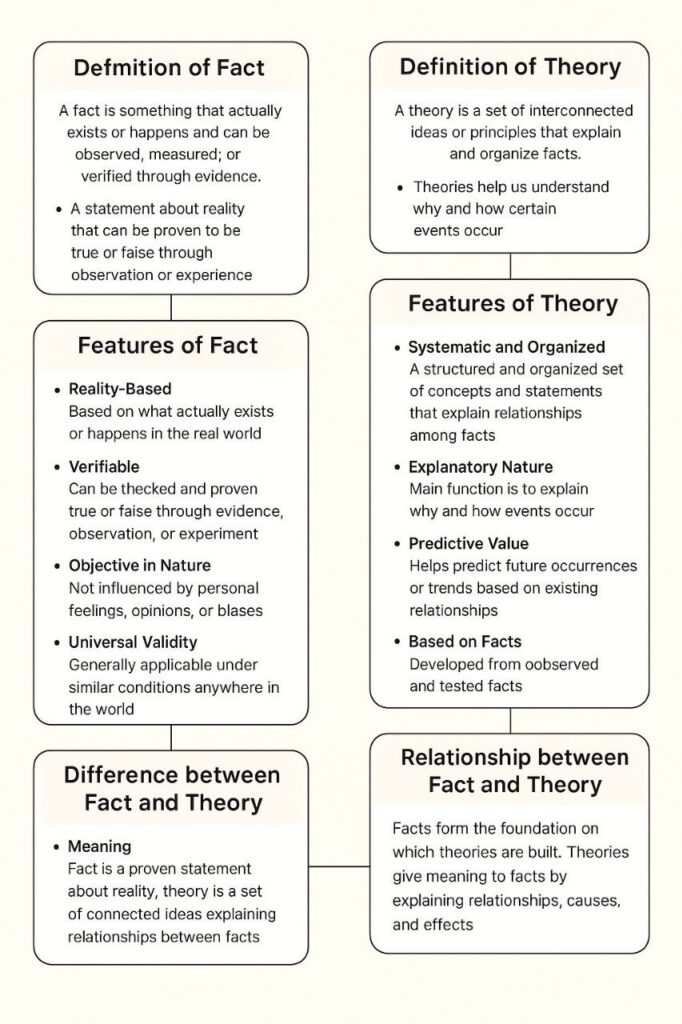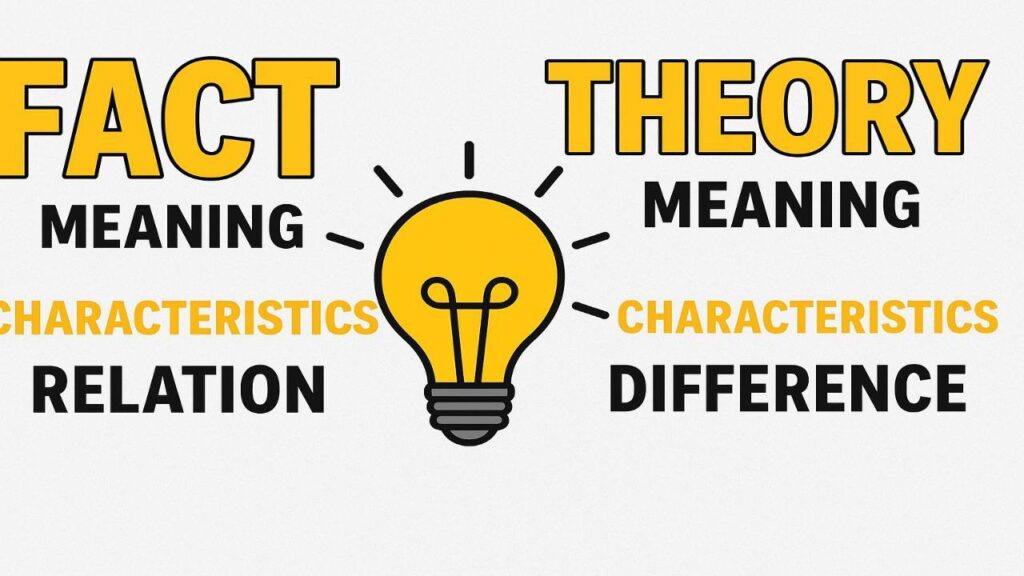In this Article we will discuss about Fact and Theory: Definition, Characteristics, Difference. In the study of knowledge, science, and particularly the social sciences, the terms Fact and Theory: Definition, Characteristics, Differenceare of central importance. Both are essential tools for understanding reality, but they serve different purposes. While a fact tells us what is, a theory helps us understand why and how it is so. A deep understanding of these two terms is crucial for scientific thinking, research, and logical analysis. The following discussion defines fact and theory, explains their features, and highlights the major differences between them with suitable examples and references from major scholars.
Fact and Theory: Definition, Characteristics, Difference
Definition of Fact
A fact is something that actually exists or happens and can be observed, measured, or verified through evidence. It is a statement about reality that can be proven to be true or false through observation or experience.
According to Goode and Hatt (2006)- Facts are thought to be definite, certain, without questions, and their meaning to be self-evident.” This means that facts are stable elements of knowledge based on evidence rather than belief or assumption.
Kerlinger (1973) defines a fact as “an observed phenomenon, or a thing that is known to be true.”
In simple terms, a fact is a verified piece of information about the world. It is a truth supported by observation and evidence.
Examples of Facts
- “The Earth revolves around the Sun.” (Scientific Fact)
- “Water freezes at 0°C under normal atmospheric pressure.” (Scientific Fact)
- “The literacy rate in India increased after independence.” (Social Fact)
- “Urban areas have higher employment opportunities than rural areas.” (Social Fact)
In sociology, Émile Durkheim (1895) introduced the concept of social facts, which he described as ways of acting, thinking, and feeling that are external to the individual but control their behavior. For example, religion, law, and customs are social facts because they exist independently of individuals and influence their actions.
Thus, facts are the foundation of knowledge. They provide raw material upon which theories are built.
- Check All – Sociology Notes in English
- Society – Meaning Definition and Characteristics
- Max Weber’s ideological theory of social change | Max Weber’s theory of social change
- Max Weber’s Bureaucracy theory
- Weber’s Theory of Ideal Types complete notes
Characteristics of Fact
Facts possess certain characteristics that make them unique and distinguish them from other forms of knowledge such as opinions, beliefs, or assumptions.
Main Characteristics of Facts:
- Reality-Based:
Facts are based on what actually exists or happens in the real world. They describe events or conditions that can be observed or experienced. Example: The population of India crossed 1.4 billion in 2024. - Verifiable:
Facts can be checked and proven true or false through evidence, observation, or experiment.- Example: The literacy rate of Kerala (as per census data) can be verified through official records.
- Objective in Nature:
Facts are not influenced by personal feelings, opinions, or biases. They remain true regardless of who observes them. - Universal Validity:
Facts are generally applicable under similar conditions anywhere in the world. Example: At sea level, water boils at 100°C—this remains the same everywhere.
- Empirical Basis:
Facts are derived from observation and experience, not from imagination or belief. - Static or Stable:
Facts usually remain unchanged unless new evidence or discoveries modify them. For example, the status of Pluto as a planet was changed when new astronomical evidence emerged. - Foundation of Knowledge:
Facts form the base upon which scientific theories, laws, and principles are constructed. Without facts, theories would be meaningless.
Definition of Theory
A theory is a set of interconnected ideas or principles that explain and organize facts. Theories help us understand why and how certain events occur.
According to Neuman (2007)- A social theory is a system of interconnected ideas that compresses and organizes knowledge about the social world.
Goode and Hatt (2006)- Theory refers to the relationships between facts or to the ordering of them in some meaningful way.
In simple language, a theory is an explanation that connects different facts and gives them meaning. It shows the relationship between variables, causes, and effects.
Examples of Theories
- Theory of Evolution (Charles Darwin): Explains how different species evolved through natural selection.
- Theory of Relativity (Albert Einstein): Explains the relationship between time, space, and gravity.
- Conflict Theory (Karl Marx): Explains how economic inequality leads to social conflict and change.
- Functionalist Theory (Émile Durkheim): Explains how different parts of society work together to maintain stability.
Therefore, while facts describe what happens, theories explain why and how those facts are connected.
Elements of Theory
The basic building blocks of any theory are:
- Concepts
- Variables
- Statements
- Formats
Let’s understand each one in simple words:
Concepts
Concepts are the main ideas or building blocks of a theory. They represent different parts of reality or social life. For example, concepts like class, education, poverty, family, or crime are used in sociology. Concepts help to focus attention on specific features of the social world. To make sure everyone understands them the same way, concepts are clearly defined. In sociology, unlike in physical sciences, we cannot use symbols or formulas, so we use words that are carefully explained.
Variables
Variables are those parts of concepts that can change or vary. They show how one thing may affect another. For example, income, education level, or age are variables. They can be different for different people or groups. Variables are important because they allow us to measure concepts and see relationships—for example, how education level (variable) affects income (another variable). In social sciences, variables are used to study how one factor changes with another.
Statements and Formats
Theories not only include concepts and variables but also show how they are connected. These connections are expressed through theoretical statements. A theoretical statement explains how and why two or more concepts or variables are related. For example, “Higher education reduces poverty” is a theoretical statement because it connects two concepts—education and poverty—and shows their relationship. When several such statements are grouped together, they form the theoretical format, which gives a complete structure to the theory.
Characteristics of Theory
Theories have distinctive features that differentiate them from facts and make them essential in understanding and explaining complex phenomena.
Main Features of Theories:
- Systematic and Organized:
A theory is a structured and organized set of concepts and statements that explain relationships among facts.- Example: Marx’s Conflict Theory systematically explains how economic inequalities lead to power struggles.
- Explanatory Nature:
The main function of a theory is to explain why and how events occur. It goes beyond describing reality—it interprets it. - Predictive Value:
Theories help predict future occurrences or trends based on existing relationships. Example: Economic theories predict market trends or inflation outcomes.
- Based on Facts:
A theory is developed from observed and tested facts. It is not imaginary but grounded in empirical evidence. - Abstract in Nature:
Theories deal with abstract ideas or relationships rather than direct observations. Example: Concepts like “class,” “power,” or “social structure” are theoretical constructs.
- Dynamic and Evolving:
Theories are not permanent truths—they change with new discoveries or evidence. Example: Newton’s theory of mechanics was expanded by Einstein’s theory of relativity.
- Logical Consistency:
The elements of a theory must be logically connected. Contradictions within a theory reduce its validity. - Guides Research:
Theories guide the process of research by helping researchers form hypotheses, design studies, and interpret data. Example: Durkheim’s theory of suicide guided researchers to study social integration and its relation to suicide rates.
Difference between Fact and Theory
Though both facts and theories are closely related, they are distinct in their nature and function. The following table highlights their key differences:
Basis of Difference Fact & Theory
| Basis of Difference | Fact | Theory |
|---|---|---|
| Meaning | A fact is a proven statement about reality, based on observation. | A theory is a set of connected ideas explaining relationships between facts. |
| Nature | Concrete and observable. | Abstract and conceptual. |
| Function | Describes what exists. | Explains why and how it exists. |
| Verification | Can be directly tested or measured. | Verified indirectly through repeated testing and observation. |
| Dependence | Independent of theory. Facts exist even without explanation. | Dependent on facts for formulation and validation. |
| Changeability | Usually stable; may change with new evidence. | Flexible; can be modified, improved, or replaced. |
| Level of Generalization | Specific and particular. | Broad and general. |
| Example (Science) | The sun rises in the east. | The heliocentric theory explains why the sun appears to rise in the east. |
| Example (Social Science) | The poverty rate is higher in rural areas. | Modernization theory explains why rural poverty persists. |
| Role in Research | Provides raw data and evidence. | Provides framework and interpretation for the data. |
Relationship between Fact and Theory
Even though facts and theories are different, they are interdependent and complementary. Facts form the foundation on which theories are built. Without facts, theories would have no evidence to stand on. Theories give meaning to facts by explaining relationships, causes, and effects.
A fact can exist without theory, but it remains meaningless or isolated until explained through a theoretical framework. Conversely, a theory cannot exist without facts, because facts provide the proof and testing ground for it.
For example:
The fact that “crime rates are higher in poor areas” becomes meaningful only when explained through Strain Theory (Robert K. Merton), which suggests that people engage in crime when they cannot achieve societal goals through accepted means.
Thus, both facts and theories work together to build and expand human knowledge.
Conclusion
In conclusion, both facts and theories play vital roles in scientific and social understanding. A fact is a verified truth about reality, while a theory is an organized system of ideas that explains and connects those facts. Facts provide the foundation of knowledge; theories provide the structure and meaning.
As Goode and Hatt (2006) rightly said, “Theory serves to order and give meaning to facts. When facts are ordered and seen in relationship, they constitute a theory.” Similarly, Neuman (2007) observed that social theory helps us organize and interpret knowledge about the social world.
In scientific inquiry, both are inseparable: facts without theory are blind, and theory without facts is empty. Facts describe the world as it is, while theories help us understand why it is so. Together, they create a complete picture of reality and guide the progress of knowledge, discovery, and social understanding.

References
Goode, W. J., & Hatt, P. K. (2006). Methods in Social Research. McGraw-Hill.
Neuman, W. L. (2007). Social Research Methods: Qualitative and Quantitative Approaches. Pearson Education.
Durkheim, É. (1895). The Rules of Sociological Method. Free Press.
Merton, R. K. (1938). Social Structure and Anomie. American Sociological Review.
Kerlinger, F. N. (1973). Foundations of Behavioral Research. Holt, Rinehart, and Winston.

